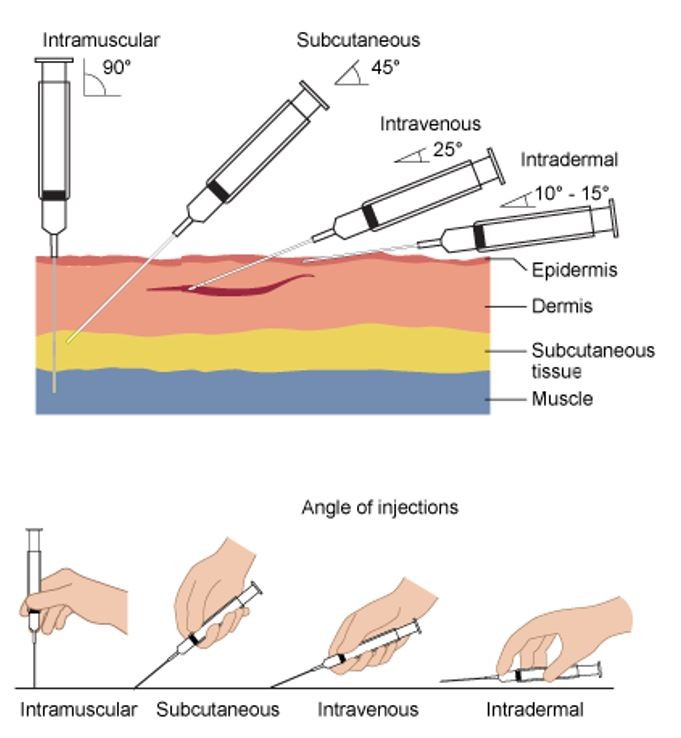How you Administer Injections Matters
Amy Barkley, Livestock Specialist
Southwest New York Dairy, Livestock and Field Crops Program
Injections are necessary, and sometimes even life-saving, for many of our livestock species. Each liquid that we inject is formulated to be placed not only in different regions of the body (think the triangular mass of muscle of the neck for most cattle vaccines vs the buttocks for some equine injections), but also in different layers of tissue (muscle vs skin vs vein). The correct placement of a needle allows the vaccine, fluid, or antibiotic to fall in the proper place to be absorbed by the body in the most effective manner. Angles of the four most common injections are listed below from largest (perpendicular with the skin surface) to smallest (nearly parallel with the skin surface).
Intramuscular: This injection is made to go deep into the muscle. The needle will be placed at a 90-degree angle (perpendicular) to the skin to allow for penetration into that tissue. A large muscle works best for these injections, but care needs to be taken with placement, especially on meat animals, since many of these injections cause damage, and ultimately condemnation, of the muscle tissue they come in contact with.
Subcutaneous: A properly placed subcutaneous injection is going to result in a lump of fluid underneath the two layers of skin (epidermis and dermis). The depth of these two layers varies with species, breed, and age. Under the skin layers resides connective tissues, which lack blood vessels, resulting in a slow absorption of any liquid placed there. An area of loose skin is an ideal place for these injections since there is room for the fluid to accumulate. The needle will be placed at an angle of 45 degrees to the skin surface.
Intravenous: The needles used for either injections or removal of blood should be placed where a vein is readily accessible. This is usually in the legs, neck, udder, or tailhead of our livestock species. Many times, the veins are readily visible, but sometimes moderate pressure needs to be applied below the area where blood is being removed to make the vein obvious. To access the vein, the needle should be inserted at an angle of 25 degrees to the skin. Drawing back on the plunger of a properly placed syringe should result in some blood in the syringe body, indicating the needle is in the vein.
Intradermal: This injection requires the needle to be placed just under the epidermis (outer layer of skin) and into the dermis (inner layer of skin). These injections take a very fine needle (larger gauge, shorter length). Correct placement of the needle is between 10 and 15 degrees with the skin surface. Correct placement is verified by the formation of a blister of fluid just under a thin layer of skin.
 Photo from Wikipedia
Photo from WikipediaUpcoming Events
Cover Crop Breeding Field Walk
May 1, 2024
Freeville, NY
You're invited to join us for a Cover Crop Breeding Field Walk!
The Cover Crop Breeding Network breeds fall-sown cover crops for traits like fall emergence, winter survival, spring vigor, high biomass, hard seed, and non-shattering pods
Join us to walk the trial fields, talk about what we're seeing (and not seeing), hear about past years' results, and learn about CCB lines approaching commercialization.
Advanced line trials - Crimson clover, hairy vetch, winter pea, and winter canola
Planting date trials - Cereal rye and winter pea
Breeding nurseries - Cereal rye and winter pea (across the road & optional!)
Meat Your Farmer 2024
May 2, 2024 : Meat Your Farmer 2024
East Aurora, NY
This event brings together livestock farmers and the community to learn about local bulk meat sales and to taste recipes created for NYS schools, featuring meats from local farms. We are currently looking for farmers to participate in the event!
Western NY Value-Added Dairy Discussion Group: Jess May- Farm Credit East Webinar
May 2, 2024
We will start our Value-Added Dairy Processing discussion group series with a guest speaker from Farm Credit East. On May 2nd at noon, Jess May will join us to discuss the lender's point of view for on-farm processing and diversification. This is free to join and will be recorded.
Announcements
No announcements at this time.





